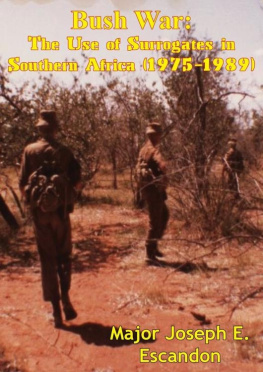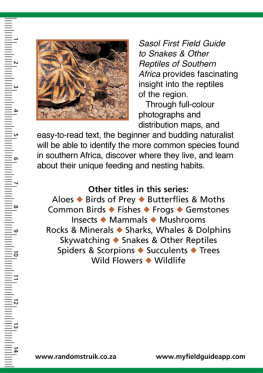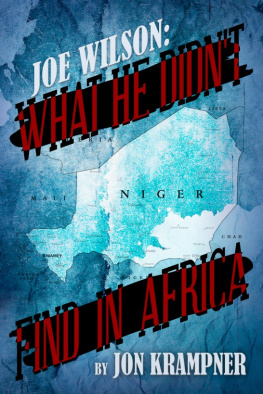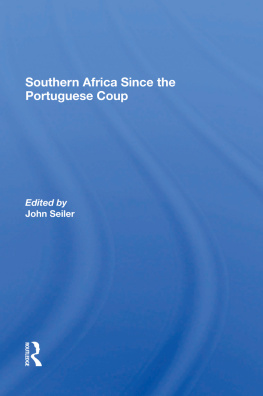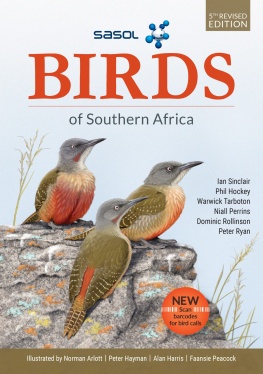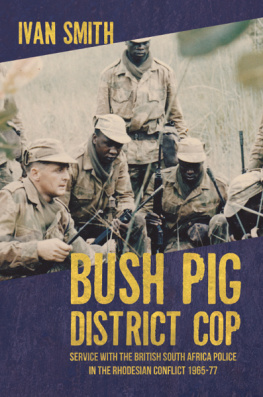Joseph E. Escandon - BUSH WAR: THE USE OF SURROGATES IN SOUTHERN AFRICA (1975-1989)
Here you can read online Joseph E. Escandon - BUSH WAR: THE USE OF SURROGATES IN SOUTHERN AFRICA (1975-1989) full text of the book (entire story) in english for free. Download pdf and epub, get meaning, cover and reviews about this ebook. year: 0, genre: Politics. Description of the work, (preface) as well as reviews are available. Best literature library LitArk.com created for fans of good reading and offers a wide selection of genres:
Romance novel
Science fiction
Adventure
Detective
Science
History
Home and family
Prose
Art
Politics
Computer
Non-fiction
Religion
Business
Children
Humor
Choose a favorite category and find really read worthwhile books. Enjoy immersion in the world of imagination, feel the emotions of the characters or learn something new for yourself, make an fascinating discovery.
- Book:BUSH WAR: THE USE OF SURROGATES IN SOUTHERN AFRICA (1975-1989)
- Author:
- Genre:
- Year:0
- Rating:3 / 5
- Favourites:Add to favourites
- Your mark:
- 60
- 1
- 2
- 3
- 4
- 5
BUSH WAR: THE USE OF SURROGATES IN SOUTHERN AFRICA (1975-1989): summary, description and annotation
We offer to read an annotation, description, summary or preface (depends on what the author of the book "BUSH WAR: THE USE OF SURROGATES IN SOUTHERN AFRICA (1975-1989)" wrote himself). If you haven't found the necessary information about the book — write in the comments, we will try to find it.
BUSH WAR: THE USE OF SURROGATES IN SOUTHERN AFRICA (1975-1989) — read online for free the complete book (whole text) full work
Below is the text of the book, divided by pages. System saving the place of the last page read, allows you to conveniently read the book "BUSH WAR: THE USE OF SURROGATES IN SOUTHERN AFRICA (1975-1989)" online for free, without having to search again every time where you left off. Put a bookmark, and you can go to the page where you finished reading at any time.
Font size:
Interval:
Bookmark:

This edition is published by PICKLE PARTNERS PUBLISHINGwww.picklepartnerspublishing.com
To join our mailing list for new titles or for issues with our books picklepublishing@gmail.com
Or on Facebook
Text originally published in 2009 under the same title.
Pickle Partners Publishing 2014, all rights reserved. No part of this publication may be reproduced, stored in a retrieval system or transmitted by any means, electrical, mechanical or otherwise without the written permission of the copyright holder.
Publishers Note
Although in most cases we have retained the Authors original spelling and grammar to authentically reproduce the work of the Author and the original intent of such material, some additional notes and clarifications have been added for the modern readers benefit.
We have also made every effort to include all maps and illustrations of the original edition the limitations of formatting do not allow of including larger maps, we will upload as many of these maps as possible.
BUSH WAR: THE USE OF SURROGATES IN SOUTHERN AFRICA (1975-1989)
By
MAJOR Joseph E. Escandon, U.S. Army
Contents
REQUEST FROM THE PUBLISHER
The purpose of this monograph is to examine the use of indigenous surrogates by both the Republic of South Africa and Rhodesia in Southern Africas Bush Wars from 1975 to 1989. The Bush Wars are of significance because the use of surrogates in each case represents policy and doctrine that is outside of the United States militarys traditional understanding and employment of surrogates.
The methodology of this paper is to analyze two unique surrogate forces to determine if they significantly contributed to the accomplishment of strategic aims and operational objectives. Such an examination is relevant because current U.S. policy and strategy advocates building the capacity of foreign security forces, as well as the use of irregular surrogate forces, to achieve U.S. foreign policy objectives.
Given the political and military challenges of Iraq and Afghanistan, policymakers believe that the United States can ill afford another long-duration, resource intensive, politically charged counterinsurgency campaign. The use of surrogates offers the promise of low-visibility, economy of force operations. Nonetheless, enthusiasm for the use of surrogates must be tempered by the reality that surrogates are not a substitute for effective operational art and strategy.
The Bush is to Southern Africa what the Outback is to Australia. It is not only a physical setting, but also has a human dimension. Simply put, the bush is no-mans land, geographic space that is dominated by untamed wilderness. Unsuited to human civilization, the bush is the domain of the animal world, a place where only bushmen, both aboriginals and adventurers, dare to tread. Nonetheless, enthusiasm for the use of surrogates must be tempered by the reality that surrogates are not a substitute for effective operational art and strategy.
As we look to the future, national security experts are virtually unanimous in predicting that the next several decades will be ones of Persistent Conflictprotracted confrontation among state, non-state and individual actors that are increasingly willing to use violence to achieve political and ideological ends.... In the years ahead, we face two major challenges to ensuring General George W. Casey Jr., Army Chief of Staff
General Caseys statement illuminates two vital shifts In other words, the U.S. cannot continue to become mired in conflicts that exhaust its military forces.
New methods must be found to meet the challenges posed by multiple adversaries. In his examination of hybrid warfare, Frank Hoffman provides insights to the methods of Americas current and future adversaries.
Hybrid
The result is that Americas adversaries will continue to adapt, so as to attack U.S. vulnerabilities and wear down the nations will over the long-term.
Hybrid wars will require unique solutions, such as those employed during the opening phases of Operation Enduring Freedom. Toppling the Taliban and Al Qaeda in Afghanistan
Nonetheless, this approach was not without problems. For instance, the use of indigenous Afghans at Tora Bora, as surrogates,
In recent years, U.S. policymakers have begun to critically examine the strategic and operational environment and develop new approaches. The U.S. National Security Strategy, as well as numerous supporting strategic documents, case studies which illustrate approaches for the use of surrogates not readily recognized in U.S. policy and doctrine. The premise of this monograph is that South Africa effectively used surrogates to accomplish operational goals and strategic aims, while Rhodesia did not.
The U.S. has a long tradition of using One of the
2006 QDRs key outcomes was the development of the Irregular Warfare (IW) concept. The with regard to doctrine, as well as roles and missions.
One of IWs indirect approaches is UW, a capability that was solidified in U.S. military doctrine during the Cold War, and is the primary vehicle for the use of surrogates. The U.S. DoD defines UW as:
a broad spectrum of military and paramilitary operations, normally of long duration, predominately conducted through, with, or by
This definition has recently been challenged by the introduction of Army Field Manual (FM) 3-05.130, Army Special Defining UW in terms of the use of surrogates is a definite improvement over previous doctrine, as is the manuals overall approach to UW.
Nonetheless, the use of surrogates still remains constrained by policy, doctrine, and organization. Many within the U.S. Army Special Forces community advocate for establishment of an UW command, independent of the to current and future conflicts will not be realized.
Fortunately, alternatives for exploring the utility of surrogates are available. In a 2006 monograph, Major Kelly Smith sought to answer the following question: Does the framework of regular and irregular [warfare] sufficiently facilitate the development of strategy, policy and doctrine for the United States to be effective in the contemporary His answer:
Unconventional warfare, and to an even greater extent, irregular warfare, are not conceptually adequate to describe the range of U.S. operations involving indigenous forces. The United States needs an updated concept that addresses the use of foreign entities, regular and irregular, in U.S. military operations.
To illustrate this point, Smith provided three
These operations do not fit comfortably into the strategic application of surrogates previously discussed. The bottom line is that the narrow scope of UW doctrine makes it difficult to extrapolate its conceptual contributions to other operations involving According to Smith, surrogate warfare is defined as:
the conduct of operations by, with, or through an entity outside of the U.S. military that performs specific functions that assist in the accomplishment of U.S. military
The value of Smiths work is that it questions current policy and doctrine, thereby opening a cognitive door for exploring fresh approaches for the use of surrogates.
While the U.S. has vast historical experience using surrogate forces, there are important lessons that can be learned from other conflicts. Two conflicts of particular interest occurred in Southern Africa. From 1966 to 1989, South Africa engaged in the so-called Bush
Next pageFont size:
Interval:
Bookmark:
Similar books «BUSH WAR: THE USE OF SURROGATES IN SOUTHERN AFRICA (1975-1989)»
Look at similar books to BUSH WAR: THE USE OF SURROGATES IN SOUTHERN AFRICA (1975-1989). We have selected literature similar in name and meaning in the hope of providing readers with more options to find new, interesting, not yet read works.
Discussion, reviews of the book BUSH WAR: THE USE OF SURROGATES IN SOUTHERN AFRICA (1975-1989) and just readers' own opinions. Leave your comments, write what you think about the work, its meaning or the main characters. Specify what exactly you liked and what you didn't like, and why you think so.

